Contacts:
Howard Lambert, President, The Freedom Foundation Virginia
howstory@aol.com; 571-251-4842;
Adam Gillenwater, Culpeper County Field Representative, The Piedmont Environmental Council
agillenwater@pecva.org; 540-347-2334, x7045
LIGNUM, VA. (Nov. 9, 2021) – On the stunningly sunny and crystal clear, crisp morning of Saturday, Nov. 6, just ahead of Veteran’s Day, some 200 people from far and wide came together in rural Culpeper County, Virginia to dedicate a new Civil War memorial site honoring three United States Colored Troops killed nearby in 1864 and the contributions of the family of a free Black man, Willis Madden. Some in attendance were descendants of United States Colored Troops who fought for the Union army during the Civil War, some were historians and history buffs, others were congregants of the historic Ebenezer Baptist Church or descendants of its founders, and still others were here to witness history being made. This Maddensville Historic Site is the first such memorial dedicated to United States Colored Troops (USCT) in Culpeper County, said to be one of the most fought-over counties during the entire Civil War.
Reflecting the historic name of this area along the once-booming crossroads of Routes 610 and 724, the beautifully landscaped Maddensville Historic Site now welcomes visitors and residents alike with an elegant granite obelisk memorializing the ultimate sacrifice of three veterans—United States Colored Troops (USCT) who were captured and executed by 9th Virginia Cavalry troops just 300 yards away on May 8, 1864. Before it stand three striking Civil War Trails markers describing the historical significance of nearby Madden’s Tavern, built between 1840 and 1852 and still standing within eyeshot of the new memorial; Ebenezer Baptist Church, established by Madden in 1867 and standing today just across the road from the new historical site; and the service and sacrifice of 17 Culpeper-born USCTs who served in the 4th Division, 9th Corps Army of the Potomac, which marched through Maddensville during the Civil War.
The ceremony was filled with reverence and aplomb: a presentation of colors by 23rd Regiment United States Colored Troops, the singing of the Battle Hymn of the Republic by Bridgette Spillman-Beckles joined by audience members, a reading of the names of the Culpeper-born troops who served in the Army of the Potomac, and recognition of active-duty and veterans present. One by one, each of three Civil War Trail markers were unveiled by affiliated persons or descendants of those they represented. And finally, to the sounds of volley fire over the field behind by members of the 23rd USCT and Co. B, 54th Massachusetts, descendents of the 27th USCTs and members of the 23rd USCT laid three wreaths upon the new monument, followed by the sounds of Taps, a call to remember those who gave their lives in service, played by SMSgt U.S. Air Force (Ret) Dave Boltz.
Keynote speaker John Hennessey, retired chief historian with the Fredericksburg and Spotsylvania National Military Park, said, “It’s easy to think of this dedication of a new collection of markers and memorials as simply that. But it is far more than that, in fact. This event is part of an inexorable, inevitable, and indispensable process of change. A change in how we see and understand our past, not by seeing less of it, but by seeing more of our past. In terms of public history and the Civil War, what we have experienced in my lifetime and yours, is equivalent to taking a pair of binoculars, and you know how when you look through them, they zoom in, but when you turn them around and look the other way, they zoom out. And in that broader picture, it’s easier for more of us to find our place in that story.”
The Maddensville Historic Site is the culmination of a years-long labor of love for Howard Lambert, president of the Freedom Foundation of Virginia, in partnership with Civil War Trails, The Piedmont Environmental Council, the Madden, Tingler and Hawkins families, and many local citizens who contributed their time and talents on fencing, landscaping, hardscaping, a reflection bench and flagpole, and many other elements of the site.
Download high resolution images from Saturday’s dedication ceremony here (photo credits are embedded in the file names).
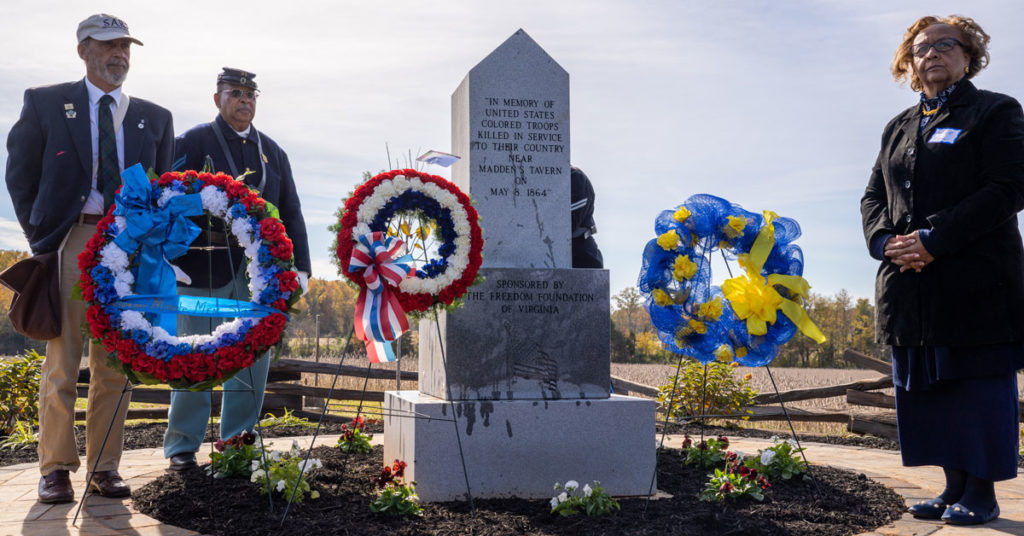
Why this Location?
Lambert chose this location, Maddensville, to honor the USCT with great intention, calling it “arguably one of the most intriguing, if not historical locations in Culpeper County, not just for the obvious reasons that colored troops were killed here. It’s a physical intersection, yes, but it is also an intersection of culture and way of life.”
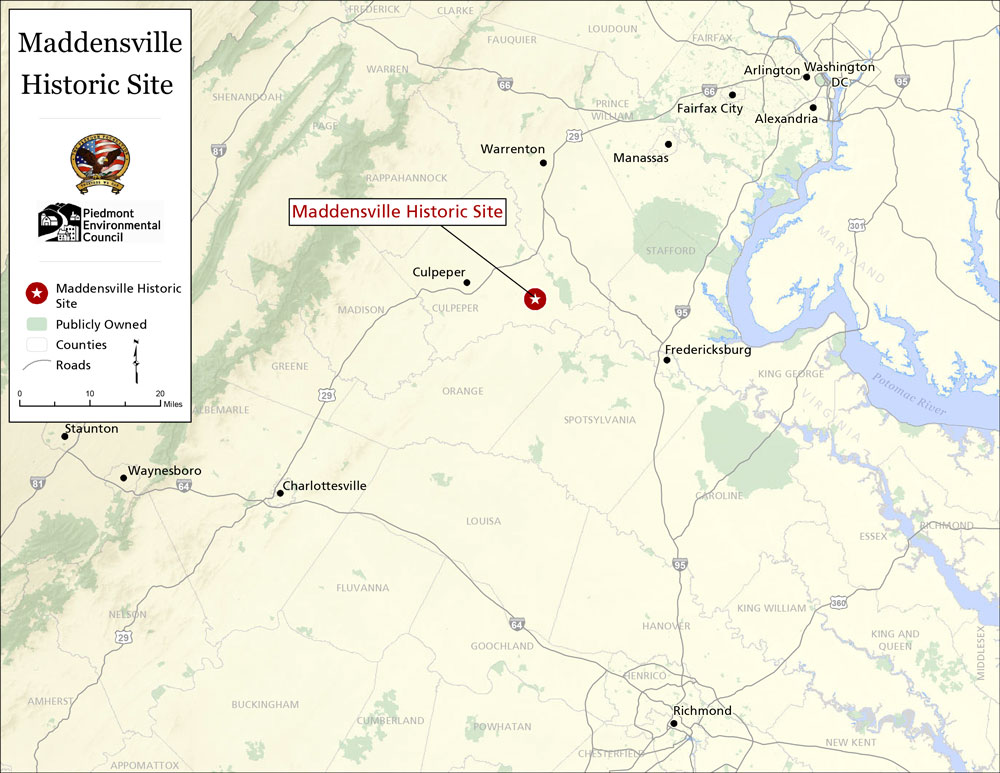
“Because what we have here is pre-Civil War with Madden’s Tavern in 1852, and we’ve got 1863 and 1864 when colored troops were allowed to join the union army and they came down this road by the thousands with the 4th Division 9th Corps toward the Battle of the Wilderness and then on to the Battle of the Crater, and then we’ve got post-Civil War, the church—by virtue of the Civil War people of color were allowed to practice our religion as we wanted to. Indeed, the Madden family shaped this portion of Culpeper County, so to be able to put a historical site here, the Maddensville Historic Site, is very, very special. It is the physical coming together of all three, and another thing that makes it special is that if you look around here, not much has changed on the lands from that time,” Lambert said.
Lambert describes Culpeper County as a kind of ground zero in the story of the United States Colored Troops, as many who were formerly enslaved went north and returned to the place of their enslavement to fight for the Union cause. “They could have stayed free and enjoyed all the privileges thereof, but these men decided to join the Union army and come back as proud soldiers in blue to fight to free people who were still in bondage, knowing that if they were captured, they would be given no quarter, but would be lined up and shot, which is obviously what happened here near Madden’s Tavern,” he said.
Of the three troops killed nearby, Lambert said, “We don’t know their identities, nor do we know precisely where they’re buried, but we know what happened and that they lay nearby. This is dedicated to those men, who made the ultimate sacrifice.”
United States Colored Troops
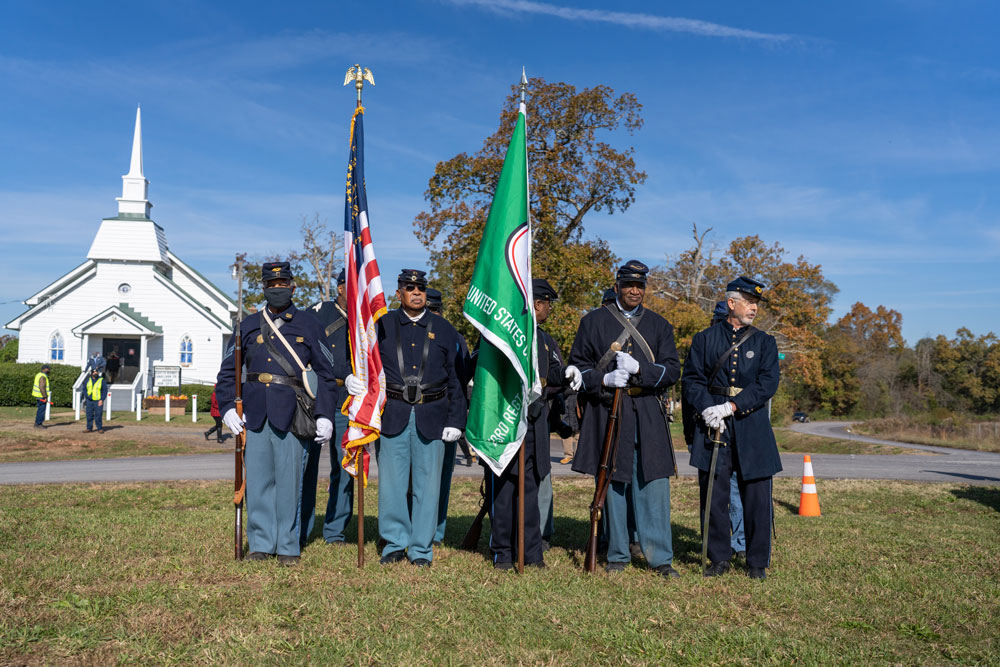
The ceremonial program read: “United States Colored Troops arrived in Culpeper at Kelly’s Ford in 1864 and would officially become members of the Army of the Potomac in May of that year. It was the first time that colored soldiers were part of the Union’s premier fighting force. The men saw action at the Battle of the Wilderness, while guarding the supply line, and at the Battle of the Crater. By the end of the war, African Americans accounted for 10 percent of the Union Army. More than 180,000 men—many former slaves—volunteered, a staggering 85 percent of the eligible population. Nearly 40,000 gave their lives for the cause.”
The Freedom Foundation of Virginia has identified nearly 120 USCTs who called Culpeper their home. “I don’t think you can fully understand and comprehend the story of the Civil War without looking at the contributions of the more than 200,000 United States Colored Troops who fought for the Union army,” Lambert said. “And you can’t, in my view, tell a full story of Culpeper County without telling the story of the United States Colored Troops, the men who left and came back, the men who made the ultimate sacrifice. And you’ve got to tell that story because it’s intricate to how the country eventually turned out. It’s truly a labor of love for me, to come back to my hometown and focus on what happened here in Culpeper County because it’s very special and near and dear to me because it’s part of my growing up and I feel the need to share with other people so they have a greater appreciation for the sacrifices of all people during the Civil War,” he said.
With the Wilderness, Chancellorsville, and Mine Run battlefields to the east, and Cedar Mountain and Brandy Station battlefield to the west, this Maddensville educational area highlighting the significant African American history associated with the Culpeper County landscape and the Civil War era will be centrally located and convenient for visitors traveling among related historic sites.
A number of USCT descendants were in attendance at the Nov. 6 ceremony. Among them were Sandra Williams, of Florida, and Brandy Station resident Eugene Triplett, of The Freedom Foundation. Their great-great grandfather French Menefee, Sr., was a member of the 27th USCT, part of the 4th Division 9th Corps that joined the Army of the Potomac and marched at this location in Culpeper. Triplett said, “I grew up in this area, and I’ve known the Maddens and Maddensville well all of my life, but I never knew the historical significance. It gives me a better appreciation for this area, knowing that I had relatives who traveled through here and who fought here. It makes me proud.”
Steward Henderson, historian and park ranger at Fredericksburg and Spotsylvania National Military Park and member of the 54th Massachusetts Volunteers Co. B, recounted an interesting history of the 4th Division of the 9th Corps, which was reconstituted General Ambrose E. Burnside, only under the condition that he had a colored division. Henderson introduced several descendants of Sgt. Daniel Steward of 23rd USCT present at the ceremony.
Madden’s Tavern
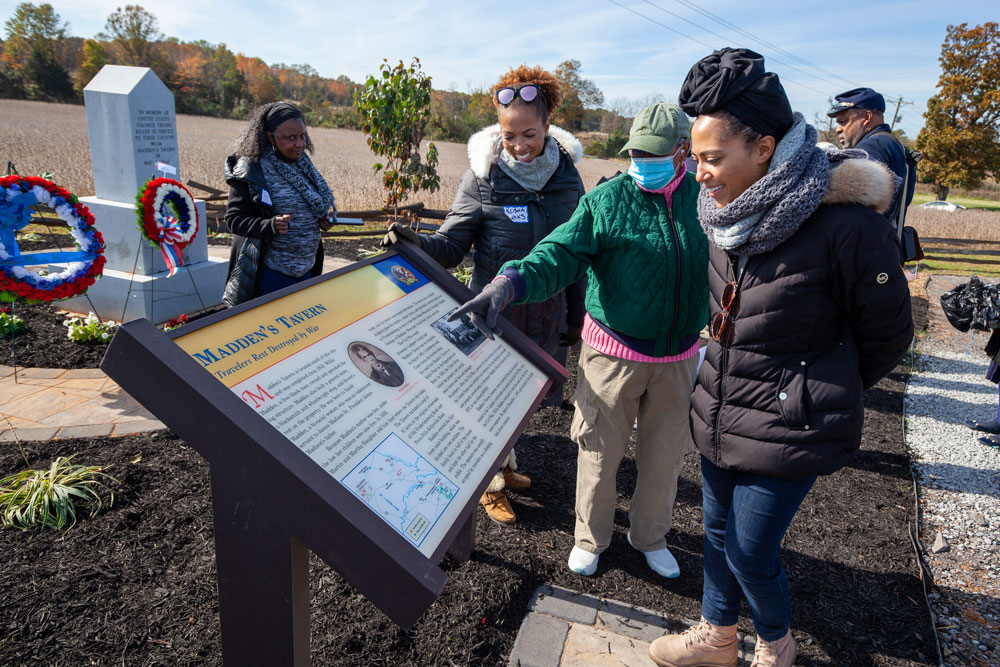
After unveiling the marker dedication to Madden’s Tavern, Bill Madden, great-great-grandson of Willis Madden, said, “I remember many discussions by my dad and other family members about Madden’s Tavern and those who passed through its doors. It is remarkable that it still stands today.” His brother, Thomas “Obed” Madden III and Obed’s wife Evelyn were also present to see their family’s Culpeper legacy recognized.
Madden’s Tavern, with its associated general store, blacksmith, and wheelwright shop, served as a popular business and rest stop frequented by travelers, teamsters, and both Union and Confederate soldiers during the Civil War. Constructed between 1840 and 1852, the story-and-a-half log structure was designed, built and operated by a free Black man, Willis Madden, whose biracial mother, Sarah, had been indentured for 30 years in the household of future president James Madison, before using her skills as a seamstress and laundress to help Willis purchase their first 87 acres of land.
Madden rose from poverty to become the respected proprietor of what is the only known Black-owned-and-operated tavern in the Virginia Piedmont prior to the Civil War. The tavern’s success allowed the Maddens to eventually acquire hundreds of acres, which they farmed extensively, giving the area the historic moniker of Maddensville, and to donate the land and building materials to help establish Ebenezer Baptist Church and an extensive African American cemetery across the road.
Though during the war, troop raids destroyed the original outbuildings and dealt the Madden’s Tavern business a fatal blow, the building remained in the Madden family as a private home until 2017. It still stands today as “a rare relic of pre-Civil War Black entrepreneurship in rural Virginia” and is included in the Virginia Landmarks Register and National Register of Historic Places. In 2001, the tavern building and 199.5 acres of surrounding farmland were permanently conserved with a conservation easement in partnership with the Virginia Outdoors Foundation and the Virginia Department of Historical Resources. The current landowners, the Tingler and Hawkins families, have graciously provided access for the Maddenville Historic Site.
Willis Madden’s great-great-granddaughter, and Bill and Obed Madden’s sister, Thomasene Madden Tarasuk, who lives in Canada and was not able to be at the ceremony, said in a previous conversation that she likens the strength of Sarah Madden to that of the troops who fought here. “I have great admiration for a woman of limited resources, but obviously not limited in fortitude and stamina, that she was able to plan for the future of her children and provide for the community of Maddensville, the church, and the community that evolved from that. Like her, the martyrs who sacrificed their lives there at Maddensville perhaps couldn’t phrase their motives as eloquently as Lincoln did, but they knew that they were fighting for a greater good—a better existence—for themselves and the Negroes who would come in future generations,” she said.
Ebenezer Baptist Church
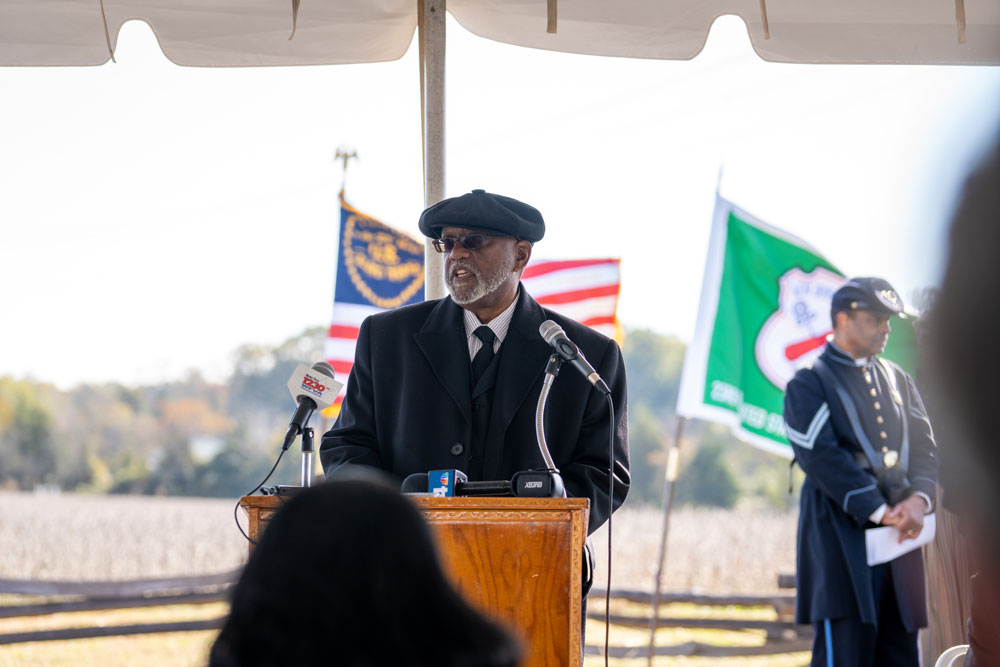
After the Civil War, African American were at last permitted to practice their religion freely, and on August 29, 1867, Willis Madden donated land and materials to help establish what was then the African Ebenezer Church and eventually an extensive African American cemetery, just north Madden’s Tavern. It was one of the first post-Civil War Black churches in Culpeper County and has long been a pillar in the African American community here. In the early years, it was a common practice for rural churches to hold services once a month with one community and then travel to neighboring communities to support fellow churches. Church records indicate that the initial church building was 24 by 30 feet and doubled as a school for 15 years before it burned in 1884. Afterward, Willis Madden’s grandson Thomas Obed Madden Sr. helped rebuild it just a few yards from its original location.
During the ceremony, Ebenezer Baptist Church deacons Michael and Betty Turner unveiled the marker dedicated to the church, as the names of its founders were read: Willis Madden, Maria Madden, Jack Davis, Robert Webb, Elizabeth Taylor, Thomas Fields and Henry Gillis. After the unveiling, Reverend Douglass Green said, “We thank you for making this possible, because someone who didn’t know will have a greater understanding of why Ebenezer stands here today for 150 years because of these markers. Prior to 1865, no religious gathering of enslaved or free people of color was permitted without the presence of a white pastor. On August 29, 1867, a free Black man named Willis Madden had a vision and a purpose to build a building known as the African Ebenezer Church. It was and has remained that purpose, to be devoted to preaching the gospel of Christ.”
Partners
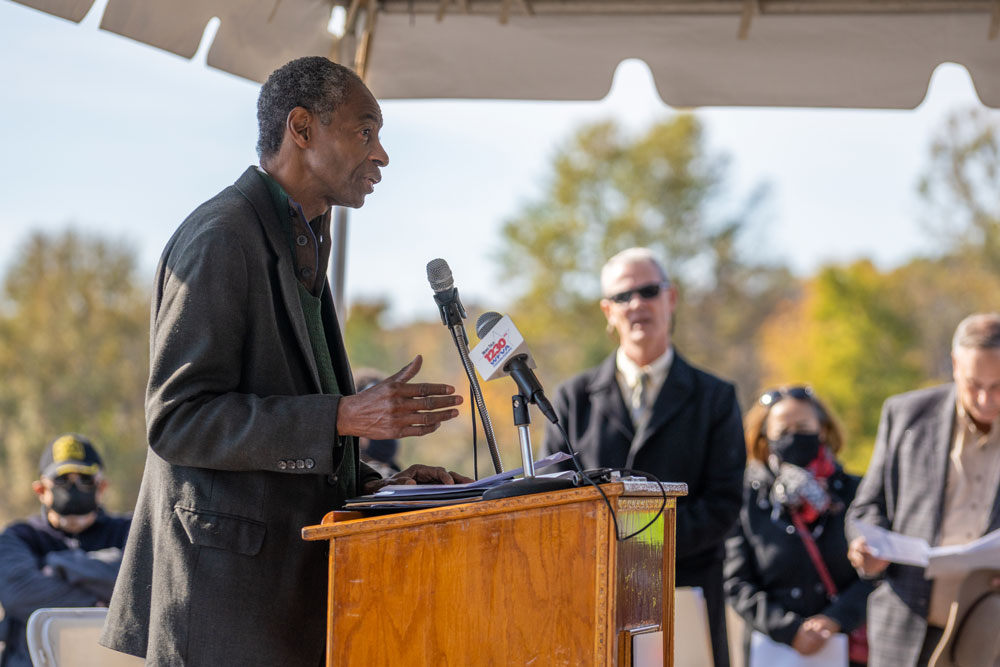
The Piedmont Environmental Council provided funding and support to help Lambert bring his vision to fruition, moving the project successfully through various county and government permitting and approval processes and raising $25,000 for the interpretive signage, obelisk, landscaping and site development.
Observing the symbolism of the timing of the dedication, between last week’s election when all could vote and Veteran’s Day next week, PEC President Chris Miller said, “We’re standing here today together as a democracy, and this is part of that. Our story is not always clean, it’s a little messy, sometimes it’s imperfect. I think collectively we’ve never given up on the idea that we can work together for a more perfect union. This commemoration and elevation of the story of the U.S. Colored Troops serves to remind us of the courage and sacrifice of those who fought to save our nation and move it closer to the highest stated ideals of justice and equality,” said PEC President Chris Miller. He went on to talk briefly about PEC’s 50-year history and continued efforts to preserve historic landscapes and resources and to bring attention to the many African American communities and stories around the region.
Civil War Trails, Inc. verified the accuracy of the historical accounts of this site and have helped the Freedom Foundation navigate the process of obtaining the three Civil War Trail markers. “The Freedom Foundation’s project not only lifts up this story, finally recognizing it on the landscape and reinserting back into the historic narrative, but also reminds communities around the nation that they too can bring their own stories to the forefront,” said Civil War Trails Executive Director Drew Gruber.
A footnote from Thomasene Madden Tarasuk: “It certainly is uncanny that on November 6, almost 158 years to the day, this project is keeping the promise to Maddensville’s group of fallen soldiers, which President Lincoln made at Gettysburg on November 19, 1863 to those buried there—that ‘their sacrifice would not be forgotten.’”
Photo, Video, Map options:
- Images from the Maddenville Historic Site dedication, credit is embedded in file names
- Video from the Maddensville Historic Site dedication (full ceremony), credit Hugh Kenny, Piedmont Environmental Council
- Maps showing the Maddensville Historic Site, Credit: Watsun Randolph, Piedmont Environmental Council
- Ebenezer Baptist Church; photo credit Hugh Kenny, Piedmont Environmental Council
#####
The Freedom Foundation was founded in 2019 and is dedicated to recognizing the contributions and legacy of Culpeper born U.S. Colored Troops. To promote for the benefit of the general public, the history, contributions and legacy of Culpeper County, Virginia born United States Colored Troops (USCTs) as well as residents of Culpeper during the American Civil War who contributed to securing freedom for its enslaved people. The primary focus shall be Culpeper born residents, however the stories and sacrifices of all Colored soldiers and their officers during the American Civil War shall also be told through advocacy and education.
Civil War Trails has been working with communities since 1994 to share their stories and connect visitors with small towns and big stories across a network that spans six states. Travelers look to Trails to put them in the footsteps of the generals, soldiers, citizens, and the enslaved who found themselves in the midst of the Civil War. Today, the program guides visitors to more than 1,200 sites, over y00 of which have become accessible to the public for the first time.Since 1972, The Piedmont Environmental Council has proudly promoted and protected the natural resources, rural economy, history and beauty of the Virginia Piedmont. PEC empowers residents to protect what makes the Piedmont a wonderful place, and works with citizens to conserve land, improve air and water quality and build thriving communities. PEC is a 501(c)(3) non-profit and accredited land trust. Learn more at www.pecva.org.
